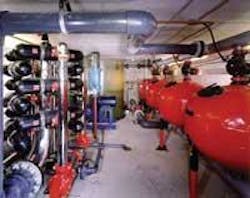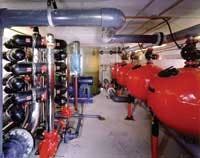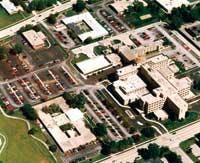Program Tests Stormwater Treatment Technologies
Recent advances in stormwater pollution treatment technologies have presented municipal stormwater managers with a vast array of product choices, but often with competing and contradictory technology specifications and product claims. Such technological differences can perplex even the most experienced manager when considering which product is ideally suited to treat urban runoff problems in one’s community. Luckily, help is on the way in the shape of a formal stormwater treatment technology verification system.
In 1998, an agreement between the EPA and NSF International (NSF) of Ann Arbor, MI, was established to provide verification testing of commercially ready technologies with applications specific to urban runoff. This agreement fell under the auspices of the ETV Wet Water Flow Pilot, which is part of the EPA’s Environmental Technology Verification Program or ETV. In 2002, the Pilot was combined with the Source Water Protection Pilot to form the Water Quality Protection Center (WQPC).
The ETV program began in 1995 with the sole mission of evaluating the performance of environmental technologies and products in all media: air, water, soil, ecosystems, pollution prevention, and monitoring. The ETV WQPC is a voluntary public/private testing partnership where manufacturers of stormwater treatment technologies volunteer to have their products independently tested.
At the core of the testing is the Stormwater Source Area Treatment Technology Protocol, which standardizes the testing procedures and parameters. At present, NSF is responsible for implementing the protocol development and testing system. Earth Tech Inc., under contract to NSF, wrote the monitoring protocol in a cooperative effort with the Wisconsin Department of Natural Resources and the U.S. Geological Survey.
Behind the Protocol
The Stormwater Source Area Treatment Protocol describes what must be included in a monitoring plan submitted for testing a stormwater treatment technology under the ETV program. The major challenges in developing the protocol included: 1) producing scientifically valid results economically; 2) adapting the protocol to be applicable to the various product designs, and 3) fitting the protocol to meet the variety of climatic conditions in the United States.
The key monitoring issues standardized by the protocol are: 1) establishment of sampling locations relative to the treatment system, 2) constituents to be analyzed and the analytical methodology, 3) number of events to be sampled, 4) definition of qualified rain events to be sampled, 5) QA/QC procedures, 6) sampling methods (automatic, flow-composited), 7) the analysis of data, and 8) the reporting format.
Key features of the protocol are as follows:
Sampling locations: The protocol calls for flow and water quality samples to be obtained from three locations: 1) raw stormwater before entering any treatment or flow splitting device, 2) treated stormwater, at the outlet of the device before mixing with any other source of water, and 3) any stormwater that bypasses the system without being treated.
Constituents to be analyzed: The parameters to be analyzed during the test are based on the claims made by the vendor. For example, if the manufacturer claims pollution treatment for nutrients, then the constituents to be analyzed must include Total Phosphorus, Dissolved Phosphorus (if the claim includes dissolved species), Total Kjeldahl Nitrogen and Nitrate-Nitrate Nitrogen.
Number of events to be sampled: The intent of the testing program is to characterize the effectiveness of the technology over a variety of rain events that are most representative of local climatic conditions. Ideally, the testing period would be over several years in order to capture the variety of climatic conditions. But because this is not economically feasible, the testing period is usually between one and two years. A minimum of fifteen qualified events must be monitored.
Qualified runoff events: The purpose of defining “qualified rain events” is to provide a guide for capturing and testing the types of storms that contribute the majority of pollutant loads.
QA/QC procedures: The objective of QA/QC is to ensure that strict methods and procedures are followed during testing so that the data obtained are valid for use in the verification of a technology. In addition, QA/QC ensures that the conditions under which samples are obtained will be properly recorded so as to be directly linked to the data, should a question arise as to its validity.
Sampling methods: The protocol describes methodologies for obtaining water quality samples from runoff events and measuring flow.
Analysis of data: Two primary performance indicators are used to characterize the performance of the stormwater treatment technology: 1) an efficiency ratio based on reduction in event mean concentration of the pollutant for each storm event, and 2) a load reduction based on the percentage of the total amount of pollutant removed. Both indicators are calculated and reported for the individual storms monitored. The load reduction will also be calculated as an average over all the sampled rainfall events. These indicators will be developed for each pollutant constituent monitored.
Report format: Results of all technology tested will be documented in a “Verification Report” and made public on the EPA and NSF websites.
Protocol in Action
At present, the practical implementation of the protocol involves both final results and ongoing analysis from three stormwater treatment systems running at three different sites in Wisconsin. The first system is the Arkal Filtration System which is a pressurized stormwater filtration system. It is located at St. Mary’s Hospital in Green Bay, WI, and is treating runoff from 5.5 acres of parking and rooftops. The Arkal system has a flow-splitter (houses both the inlet and bypass pipes) and a 9,200 cu. ft. holding tank designed to carry runoff generated from a 2-year, 30-minute duration event. The manufacturer claims 80 percent of suspended solids greater than 5 microns will be removed.
The second stormwater treatment technology is installed near the Milwaukee River in Milwaukee, WI, to treat 0.23 acres of freeway runoff. This site employs a Vortechs stormwater treatment system, which is a hydrodynamic device designed and manufactured by Vortechnics Inc. The specific model being analyzed is the Vortechnics 1000 which has three chambers to control totals suspended solids (TSS), floating oil, and debris in runoff with a design flow rate of 1.6 cfs.
Pollutants are captured in several chambers. The grit chamber is controlled by an orifice designed to pass smaller flows equivalent to the 2-month storm. Larger storms flow over the top of the grit chamber into the middle chamber. The vendor claims that flow patterns into the chamber create swirling actions helping sediment to drop out. The manufacturer also claims that 80 percent of the suspended solids greater than 250 microns will be removed.
A third site using a product manufactured by Stormwater Management Inc. is located adjacent to the Vortechs site in Milwaukee. The StormFilter relies on a filtration process for pollution removal.
Final analysis from both the Arkal product and the StormFilter are complete and posted on the EPA web site. In fact, independent verification under the protocol has determined that the Arkal system has met and in some cases exceeds the manufacturer’s claims. The StormFilter product achieved a reduction of 46 percent TSS loading, and 92 percent reduction of the suspended solids concentration (SSC).
While results from such testing should not be considered an endorsement of the manufacturer’s product, they should be viewed as a comparative guide when considering one product versus another. Results from verification testing of the Arkal and StormFilter system can be found at the NSF International web site: http://www.nsf.org/business/water_quality_protection_center/reports.asp?prog . The Verification Report on the Vortechs device is expected to be completed in 2005.
Moving Forward
As the ETV WQPC program continues to advance, it is likely that the final protocol document will undergo revisions as more products are tested. Indeed, NSF is accepting testing applications from vendors who wish to participate in the ETV. To participate, vendors must be willing to contribute financially to the cost of the verification testing and assist in developing a test plan following the protocol. Once the test plan is reviewed and approved by the EPA and NSF, a third party testing organization conducts the test.
In the end, this type of public/private testing relationship will enhance the decision-making process for watershed managers considering costly investments in stormwater pollution treatment technologies. As the protocol continues to evolve, with input from practical field-testing, the decision making process will become simpler and the technology choices more clear. Additional information regarding the protocol and the ETV program can be found at: http://www.epa.gov/etv/verifications/vcenter9-9.html. WW
About the Author
James A. Bachhuber, P.H, is an employee of Long Beach, Calif.-based Earth Tech Inc., a business unit of Tyco Engineered Products & Services and a global provider of consulting, engineering and construction services. Bachhuber is based in Earth Tech’s Madison, WI, office and is responsible for overseeing the ETV WQPC implementation at three sites in Wisconsin in collaboration with NSF, the Wisconsin Department of Natural Resources, and the US Geologic Survey.


